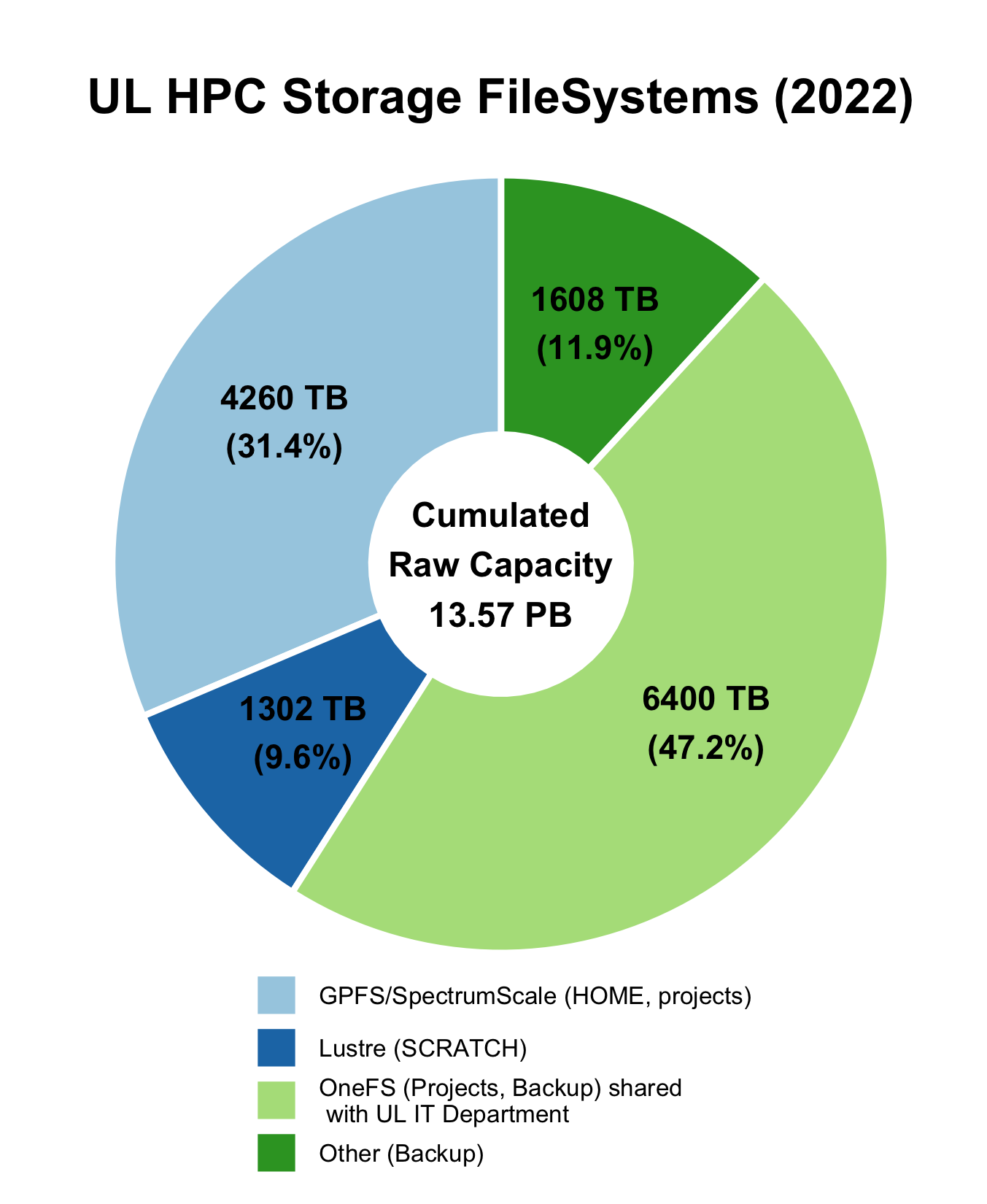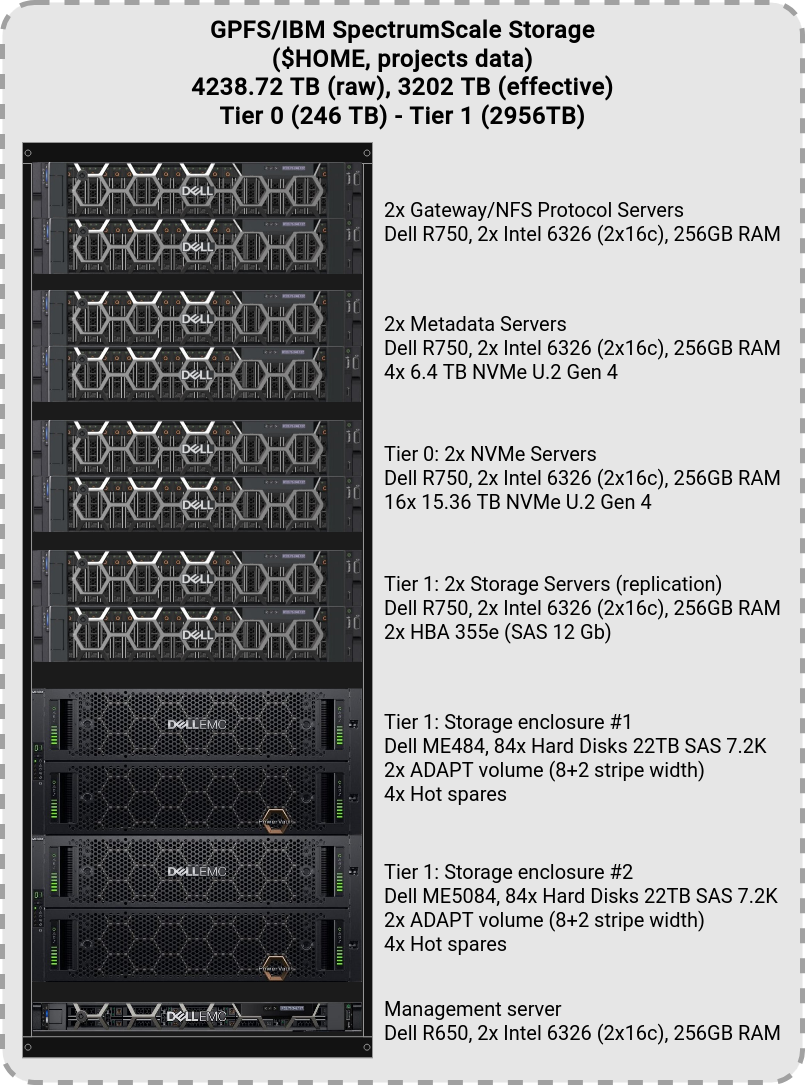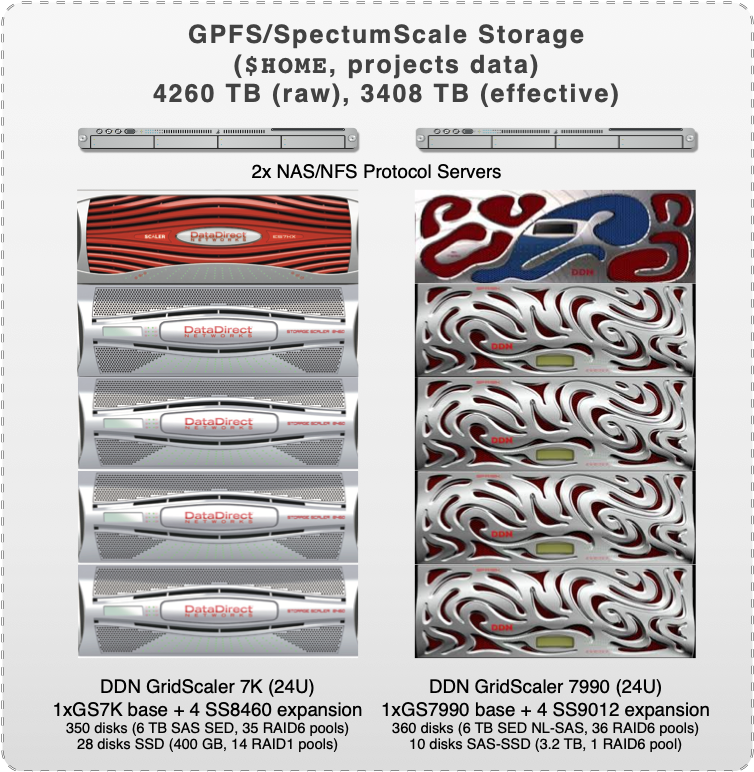GPFS/SpectrumScale¶

Introduction¶
IBM Spectrum Scale, formerly known as the General Parallel File System (GPFS), is high-performance cluster file system available on all ULHPC computational systems through a Dell-based storage infrastructure.
It allows sharing home directories and project data between machines, users, systems, and (if needed) with the "outside world". In terms of raw storage capacities, it represents more than 4PB of raw space (more than 3PB of usable space).
The file system is composed of two tiers, home directories are stored on the Tier 0 (Flash-based, 246TB) while project directories are stored on the Tier 1 (Disk-based, 2956TB). The placement policy can be adjusted, in example, for publicly shared datasets.
Home directory (${HOME})¶
Home directories provide access to configuration files (such as dotfiles) and work files (such as binaries and input and output files) across all cluster nodes. Use home to store working data that are accessed by multiple processes in compute nodes and configuration files.
- Home directories are mirrored and cached in Tier 0 storage, so small file and random I/O is relatively fast but not as fast as local storage.
- The GPFS file system storing the home directories is redundant, so it is safe to data and access loss due to hardware failure.
The environment variable ${HOME} points to a user's home directory. The absolute path may change, but the value of ${HOME} will always be correct.
Project directories (${PROJECTHOME})¶
Project directories share files within a group of researchers, and are accessible under the path /work/projects/<project name> in every cluster node. Use project directories to share files and to store large data files that are actively used in computations.
- Project directories are not mirrored in Tier 0 storage, so small file I/O performance is lower that the home directory.
- Since project directories are not mirrored in Tier 0 storage, the available storage space is much larger.
- The GPFS file system storing the project directories is redundant, so it is safe to data and access loss due to hardware failure.
The environment variable ${PROJECTHOME} points to the parent directory of all projects (/work/projects). The absolute path to the project home directory may change, but ${PROJECTHOME} is guaranteed to point to the parent directory of all projects directories.
Global Project quotas and backup policies
See quotas for detailed information about inode, space quotas, and file system purge policies. Your projects backup directories are backuped weekly, according to the policy detailed in the ULHPC backup policies.
Access rights to project directory: Quota for clusterusers group in project directories is 0 !!!
When a project <name> is created, a group of the same name (<name>) is also created and researchers allowed to collaborate on the project are made members of this group,which grant them access to the project directory.
Be aware that your default group as a user is clusterusers which has (on purpose) a quota in project directories set to 0.
You thus need to ensure you always write data in your project directory using the <name> group (instead of yoru default one.).
This can be achieved by ensuring the setgid bit is set on all folders in the project directories: chmod g+s [...]
When using rsync to transfer file toward the project directory /work/projects/<name> as destination, be aware that rsync will not use the correct permissions when copying files into your project directory. As indicated in the Data transfer section, you also need to:
- give new files the destination-default permissions with
--no-p(--no-perms), and - use the default group
<name>of the destination dir with--no-g(--no-group) - (eventually) instruct rsync to preserve whatever executable permissions existed on the source file and aren't masked at the destination using
--chmod=ug=rwX
Your full rsync command becomes (adapt accordingly):
rsync -avz {--update | --delete} --no-p --no-g [--chmod=ug=rwX] <source> /work/projects/<name>/[...]
For the same reason detailed above, in case you are using a build command or
more generally any command meant to write data in your project directory
/work/projects/<name>, you want to use the
sg as follows:
# /!\ ADAPT <name> accordingly
sg <name> -c "<command> [...]"
This is particularly important if you are building dedicated software with Easybuild for members of the project - you typically want to do it as follows:
# /!\ ADAPT <name> accordingly
sg <name> -c "eb [...] -r --rebuild -D" # Dry-run - enforce using the '<name>' group
sg <name> -c "eb [...] -r --rebuild" # Dry-run - enforce using the '<name>' group
Danger
Redundancy does not replace backups. Home and project directories are redundant but not backed up, so do not leave data stored in home and project directories.
${HOME} quotas and backup policies
See quotas for detailed information about inode, space quotas, and file system purge policies. Your HOME is backuped weekly, according to the policy detailed in the ULHPC backup policies.
Storage System Implementation¶
The way the UL HPC GPFS file system is implemented is depicted on the below figure.

It is composed of:
- Two gateway NFS servers (see below)
- Two metadata servers (Dell R750 containing 4x 6.4TB NVMe each)
- Two Tier 0 servers (Dell R750 containing 16x 15.36TB NVMe each), configured as replicas
- Two Tier 1 servers (Dell R750, attached to the disk enclosures below)
- One ME484 disk enclosure, containing 84x SAS hard disks of 22TB, configured in 2x ADAPT volumes plus 4x hot spares
- One ME5084 disk enclosure, containing 84x SAS hard disks of 22TB, configured in 2x ADAPT volumes plus 4x hot spares
There is no single point of failure within the storage solution and the setup is fully redundant (servers are set-up in pairs, and the system can tolerate the loss of one server in each pair). There are redundant power supplies, redundant fans, redundant storage controller and battery backup to secure the cache data when power is lost completely. The data paths to the disk enclosures are redundant so that links can fail, and the system will still be fully operational.
Finally, each server is connected directly to the Aion Infiniband network via redundant HDR200 links, in such a way that all connections are perfectly balanced across the 4 Aion racks and 8 leaf switches, and connected to a redundant stack of ethernet switches via redundant 10GbE links.
(Obsolete) Initial DDN-Based GPFS infrastructure
Our DDN-based GPFS infrastructure has unfortunately reach End-of-Life and could not be supported anymore. It has been replaced in 2024 by the new Dell-based infrastructure described above. For the record, the following section describes the now decommissioned DDN system:

- Two NAS protocol servers (see below
- One DDN GridScaler 7K system acquired as part of RFP 160019 deployed in 2017 and later extended, composed of
- 1x DDN GS7K enclosure (~11GB/s IO throughput)
- 4x SS8460 disk expansion enclosures
- 350x HGST disks (7.2K RPM HDD, 6TB, Self Encrypted Disks (SED) configured over 35 RAID6 (8+2) pools
- 28x Sandisk SSD 400GB disks
- Another DDN GridScaler 7K system acquired as part of RFP 190027 deployed in 2020 as part of Aion and later extended.
- 1x DDN GS7990-EDR embedded storage
- 4x SS9012 disk expansion enclosures
- 360x NL-SAS HDDs (6TB, Self Encrypted Disks (SED)) configured over 36 RAID6 (8+2) pools
- 10x 3.2TB SED SAS-SSD for metadata.
Filesystem Performance¶
The performance of the storage infrastructure via native GPFS and RDMA based data transport for the HPC filesystem is expected to be:
- on Tier 0, in the range of 23GB/s for sequential reads, and 55GB/s for sequential writes
- on Tier 1, in the range of 10GB/s for large sequential reads and writes Performance measurement by IOR, a synthetic benchmark for testing the performance of distributed filesystems, has been performed prior to the acceptance of the storage solution.
The IOR benchmark
IOR is a parallel IO benchmark that can be used to test the performance of parallel storage systems using various interfaces and access patterns. It supports a variety of different APIs to simulate IO load and is nowadays considered as a reference Parallel filesystem I/O benchmark. It recently embedded another well-known benchmark suite called MDTest, a synthetic MPI parallel benchmark for testing the metadata performance of filesystems (such as Lustre or Spectrum Scale GPFS) where each thread is operating its own working set (to create directory/files, read files, delete files or directory tree).
Gateway/NFS Servers¶
Two Gateway servers are available, each connected via 2 x IB HDR200 links to the IB fabric and exporting the filesystem via NFS and SMB over 2 x 10GE links into the Ethernet network.